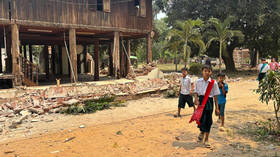Build that wall: Climate scientists propose walling off Antarctic ice sheets to protect them

A group of researchers have devised an audacious proposal to stave off one of the worst effects of climate change: building a massive wall under the Antarctic ice sheet to keep it frozen place for the next millennium.
It would constitute the largest geoengineering project in humanity’s history, aimed at preventing a precipitous rise in sea-levels that would render major coastal cities on both sides of the Atlantic uninhabitable, frozen wastelands, causing trillions of dollars-worth of damage and potentially killing or displacing hundreds of millions of people.
"Doing geoengineering means often considering the unthinkable," John Moore, one of two authors of the new study, published in The Cryosphere, said in a statement. Moore added that such an "ice sheet intervention today would be at the edge of human capabilities."
READ MORE: Enormous 4 mile long iceberg filmed breaking from Greenland glacier (VIDEO)
The study considers both the Antarctic and Greenland ice sheets as its main test subjects, with particular focus on the Thwaites Glacier in West Antarctica, widely considered the canary in the coalmine as far as ice sheet destruction is concerned. If it were to collapse, sea level rise would be catastrophic while the Gulf Stream would be destroyed almost entirely.
"Thwaites could easily trigger a runaway [West Antarctic] ice sheet collapse that would ultimately raise global sea level by about 3 meters (10 feet)," Michael Wolovick, a geosciences researcher at Princeton and the other author of the study, said.
However, all of the ice shelves in question, if melted, could raise sea levels across the globe by an estimated 200 feet (60 meters) according to one study published in the Journal Nature. For context, global sea levels rose by roughly just six inches on average during the 20th century, leading to a shoreline encroachment of about 50 feet (15 meters) along the eastern seaboard of the US.
READ MORE: Volcanic heat source discovered under melting Antarctic glacier
The authors’ proposal involves building “very simple structures” or walls underneath major ice sheets to prevent erosion and melting caused by the influx of warm water from below; the world’s oceans have absorbed a huge amount of the heat caused by climate change and the burning of fossil fuels. The pair concentrated their proposal on the Thwaites Glacier, which is roughly 80 to 100 km in width, as a test case.
The authors also expressed concern that the fossil fuel industry would see such an engineering project as a ‘get out of jail free card’ that would allow it to continue extracting coal, oil and gas for combustion, pumping even more greenhouse gases into the atmosphere.
“There are dishonest elements of society that will try to use our research to argue against the necessity of emissions’ reductions. Our research does not in any way support that interpretation,” the authors note.
Another potential criticism of the proposal is that it would merely treat a symptom, not a cause, of climate change while other factors such as drought, increasingly intense storm systems and ocean acidification among others, would continue to worsen.
“The most important result [of our study] is that a meaningful ice sheet intervention is broadly within the order of magnitude of plausible human achievements,” says Wolovick. “If [glacial geoengineering] works there then we would expect it to work on less challenging glaciers as well.”
Think your friends would be interested? Share this story!















